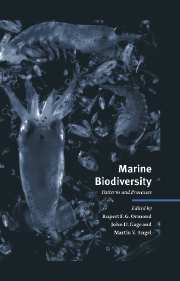Book contents
- Frontmatter
- Contents
- List of contributors
- Foreword: The value of diversity
- 1 Marine biodiversity in its global context
- 2 Gradients in marine biodiversity
- 3 Pelagic biodiversity
- 4 Biological diversity in oceanic macrozooplankton: More than counting species
- 5 Large-scale patterns of species diversity in the deep-sea benthos
- 6 Diversity, latitude and time: Patterns in the shallow sea
- 7 High benthic species diversity in deep-sea sediments: The importance of hydrodynamics
- 8 Diversity and structure of tropical Indo-Pacific benthic communities: Relation to regimes of nutrient input
- 9 Why are coral reef communities so diverse?
- 10 The biodiversity of coral reef fishes
- 11 The historical component of marine taxonomic diversity gradients
- 12 Population genetics and demography of marine species
- 13 Discovering unrecognised diversity among marine molluscs
- 14 Ecosystem function at low biodiversity – the Baltic example
- 15 Land–seascape diversity of the USA East Coast coastal zone with particular reference to estuaries
- 16 The development of mariculture and its implications for biodiversity
- 17 Protecting marine biodiversity and integrated coastal zone management
- 18 Conserving biodiversity in North-East Atlantic marine ecosystems
- Author index
- Species index
- Subject index
11 - The historical component of marine taxonomic diversity gradients
Published online by Cambridge University Press: 04 August 2010
- Frontmatter
- Contents
- List of contributors
- Foreword: The value of diversity
- 1 Marine biodiversity in its global context
- 2 Gradients in marine biodiversity
- 3 Pelagic biodiversity
- 4 Biological diversity in oceanic macrozooplankton: More than counting species
- 5 Large-scale patterns of species diversity in the deep-sea benthos
- 6 Diversity, latitude and time: Patterns in the shallow sea
- 7 High benthic species diversity in deep-sea sediments: The importance of hydrodynamics
- 8 Diversity and structure of tropical Indo-Pacific benthic communities: Relation to regimes of nutrient input
- 9 Why are coral reef communities so diverse?
- 10 The biodiversity of coral reef fishes
- 11 The historical component of marine taxonomic diversity gradients
- 12 Population genetics and demography of marine species
- 13 Discovering unrecognised diversity among marine molluscs
- 14 Ecosystem function at low biodiversity – the Baltic example
- 15 Land–seascape diversity of the USA East Coast coastal zone with particular reference to estuaries
- 16 The development of mariculture and its implications for biodiversity
- 17 Protecting marine biodiversity and integrated coastal zone management
- 18 Conserving biodiversity in North-East Atlantic marine ecosystems
- Author index
- Species index
- Subject index
Summary
Abstract
In the past it has been widely assumed that latitudinal diversity gradients in the marine realm must be underpinned in some way by a cline in evolutionary rates. Although there is some theoretical justification for believing that speciation is enhanced in the tropics and extinction towards the poles, this has not been borne out so far by empirical studies based on the fossil record. A detailed comparison of ten tropical and ten temperate molluscan clades showed that, although the former were, on average, three times as diverse as the latter, they had not radiated at a significantly faster rate. Many temperate clades, in both the marine and terrestrial realms, appear to have evolved comparatively rapidly; they are less diverse at the present day simply because they are geologically younger. Available evidence from the marine realm suggests that extinction is no more likely in cold than in warm waters. Explanations of large-scale biodiversity patterns may now reside more in regional rather than local phenomena. In particular, extant latitudinal taxonomic diversity gradients may reflect as much range fluctuation in response to Cenozoic climatic cycles as to any intrinsic properties of either tropical or polar biotas.
Introduction
In recent years there has been a growing realisation that the patterns of biodiversity we see today may be the product of a substantial historical legacy.
- Type
- Chapter
- Information
- Marine BiodiversityPatterns and Processes, pp. 258 - 273Publisher: Cambridge University PressPrint publication year: 1997
- 16
- Cited by



